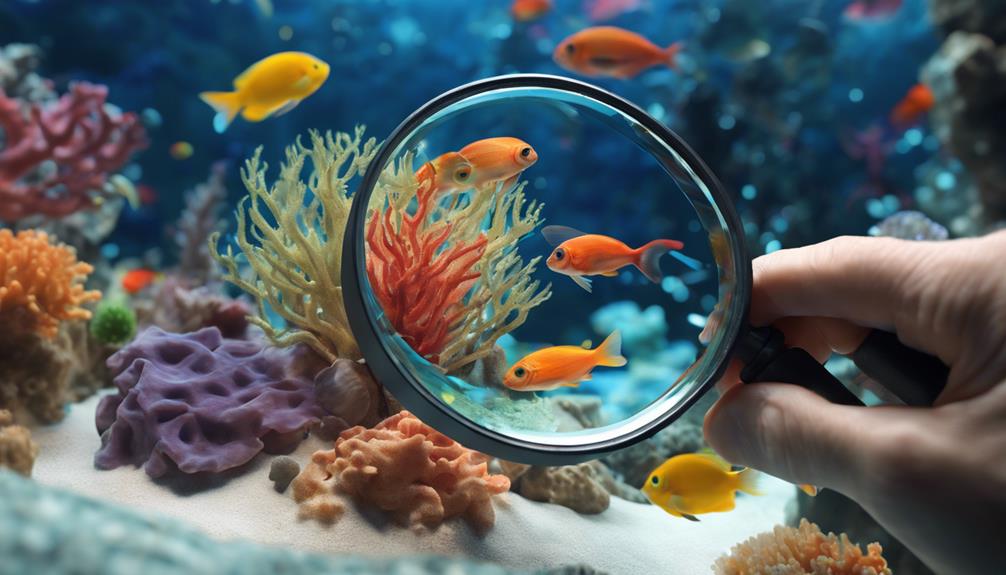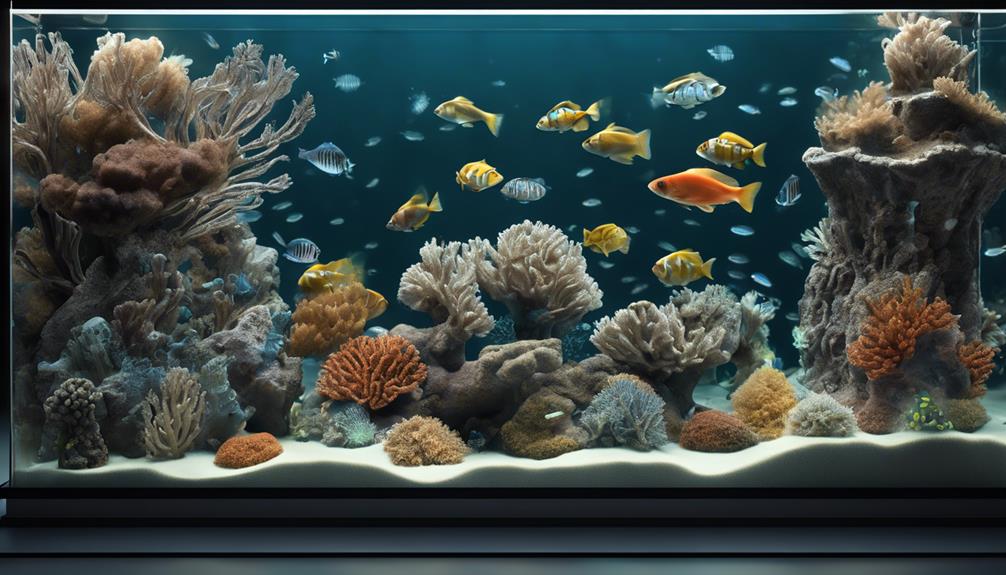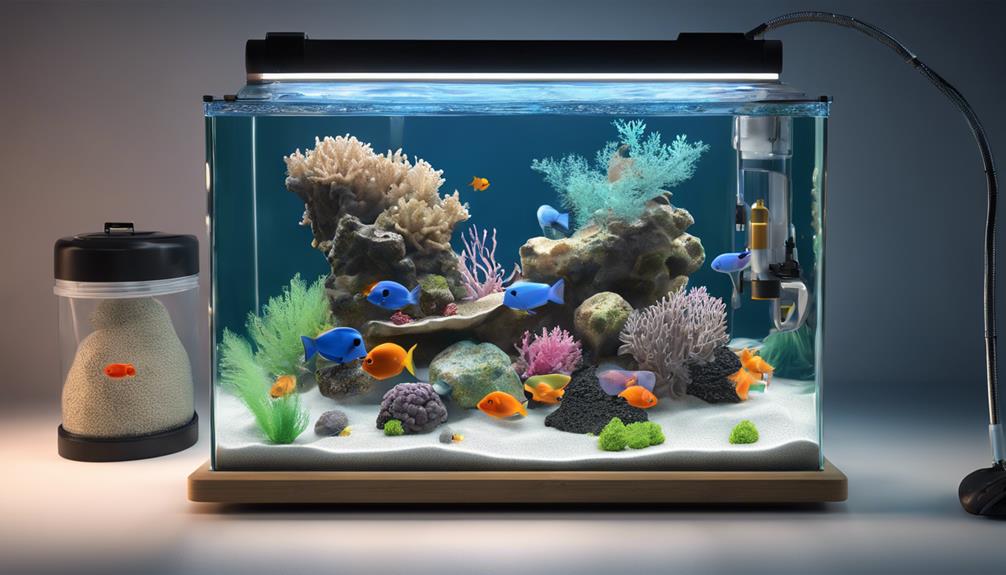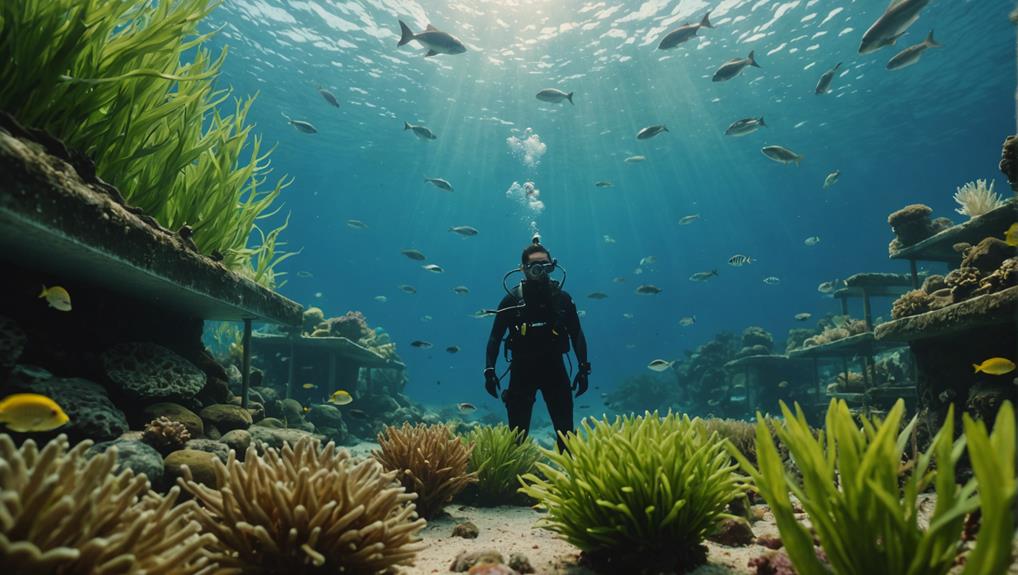To keep your saltwater aquarium thriving, you'll need to perform seven essential maintenance tasks regularly. Start by conducting weekly water changes and testing, replacing 10-20% of tank water with high-quality, purified RO/DI water. You'll also need to clean your mechanical filtration system bi-weekly and inspect your glass and equipment monthly. Regular protein skimmer maintenance, quarterly algae and detritus removal, and semi-annual filter media replacement are also vital. Finally, perform an annual aquarium overhaul and upgrade to prevent equipment failure and maintain a healthy environment. By following these tasks, you'll be well on your way to creating a thriving aquatic ecosystem, and exploring these tasks in more depth will reveal the intricacies of each process.
Key Takeaways
- Perform weekly water changes, replacing 10-20% of tank water with high-quality, purified RO/DI water to replenish trace elements and remove waste.
- Regularly test water parameters, including ammonia, nitrite, nitrate, pH, alkalinity, calcium, magnesium, phosphate, and salinity to maintain stable water chemistry.
- Clean and replace filter media, including filter socks, protein skimmer collection cups, and intake vents, to ensure peak mechanical and biological filtration efficiency.
- Inspect and clean equipment, including pumps, heaters, and filters, to prevent equipment failure and maintain water quality.
- Regularly remove algae and detritus from the tank, including scrubbing surfaces, vacuuming the substrate, and cleaning decorations, to maintain a healthy and thriving aquarium.
Weekly Water Change and Testing
To maintain ideal water quality and prevent the buildup of toxins, you should perform a weekly water change and testing regimen in your saltwater aquarium.
This involves replacing 10-20% of the tank water with high-quality, purified RO/DI water to replenish trace elements and remove accumulated waste. Consistency is key when mixing saltwater, so use a high-quality salt mix and guarantee the water is changed and heated to the appropriate tank temperature before refilling the aquarium.
Verify salinity levels in both the display aquarium and clean saltwater mixing bin to facilitate a seamless shift and prevent shocking the fish.
In addition to water changes, perform an exhaustive water test weekly to monitor parameters such as ammonia, nitrite, nitrate, pH, alkalinity, calcium, magnesium, phosphate, and salinity.
This will help identify any potential issues before they become major problems. Record test results and water changes in a logbook or spreadsheet to track changes over time and make any necessary adjustments to maintain stable water parameters.
Bi-Weekly Mechanical Filtration Cleaning
Now that you've tackled your weekly water change and testing, it's time to focus on bi-weekly mechanical filtration cleaning.
You'll want to pay attention to two critical areas: replacing your filter socks to prevent clogging and maintain water clarity, and cleaning your protein skimmer to guarantee peak performance.
Filter Sock Replacement
Regularly swapping out your filter socks is crucial for maintaining the health and balance of your saltwater aquarium, as clogged filters can quickly lead to water quality issues.
You should replace your filter socks every 1-2 weeks, or as needed, to prevent clogging and maintain peak mechanical filtration efficiency. Failure to do so can lead to a buildup of debris and waste, causing water quality issues and potentially harming your aquatic life.
When replacing filter socks, gently rinse them in a bucket of tank water to remove any debris and prevent introducing air into the system.
Reusable filter socks can be cleaned and reused multiple times, but it's recommended to replace them every 2-3 months to maintain their effectiveness.
Handle filter socks carefully to avoid damaging them, and make sure to secure them properly to prevent them from getting sucked into the pump or other equipment.
Protein Skimmer Cleaning
You'll need to clean your protein skimmer every two weeks to maintain its peak performance and prevent the buildup of debris and detritus that can hinder its efficiency. This bi-weekly mechanical filtration cleaning task is vital for ideal aquarium water quality and circulation.
Clean the collection cup and intake vent by removing any accumulated debris and detritus to prevent clogging and maintain proper water flow.
Rinse the protein skimmer and its parts with a bucket of tank water and a cleaning solution to remove algae and debris.
Reassemble and replace the protein skimmer in the tank to maintain proper water circulation and filtration.
Regularly empty and clean the collection cup to prevent the accumulation of organic waste and maintain water quality.
Monthly Glass and Equipment Inspection

As part of your monthly maintenance routine, inspecting the glass and equipment is crucial to maintaining ideal water quality and preventing equipment failure.
You'll want to start by cleaning the exterior glass panels and/or lid using an aquarium-safe glass cleaner to prevent salt creep and maintain visibility.
Next, inspect the sump, filtration equipment, and tank edges for salt creep or buildup, and remove any you find using a cleaning solution.
Don't forget to clean the protein skimmer collection cup and intake vent to guarantee peak performance and prevent clogging.
Move on to inspecting all equipment, including pumps, heaters, and filters, to verify they're functioning properly and show no signs of wear and tear.
Regular cleaning and inspection of equipment can help prevent equipment failure, maintain water quality, and reduce the risk of livestock disease and death.
Regular Protein Skimmer Maintenance
Your protein skimmer relies on consistent maintenance to enhance its performance and keep your saltwater tank healthy.
Without regular cleaning and maintenance, your protein skimmer can become clogged, reducing its effectiveness and impacting water quality.
To keep your protein skimmer running smoothly, follow these maintenance tasks:
Clean the collection cup and intake vent every 1-2 weeks to prevent clogging and maintain peak performance.
Empty and clean the collection cup after each use to prevent the buildup of concentrated organic matter and maintain water quality.
Rinse the protein skimmer and its parts with tank water to remove any debris or algae, and reassemble the skimmer after cleaning.
Replace the air intake valve and vent every 3-6 months to maintain proper airflow and prevent clogging.
Quarterly Algae and Detritus Removal

To maintain a pristine saltwater tank, dedicate time every quarter to removing algae and detritus that can accumulate on rocks, decorations, and glass walls, as well as in the substrate.
You'll need to scrub all surfaces with a magnetic algae scraper or algae brush to remove stubborn algae and debris. Don't forget to use a gravel vacuum to remove detritus and waste from the substrate, focusing on areas with high waste buildup and stirring up the gravel to release trapped debris.
Remove and clean all decorations, rocks, and other ornaments, and soak them in a bucket of tank water with a cleaning solution to remove algae and debris.
Use a soft-bristled brush to gently scrub away algae and debris from delicate decorations and rocks, and rinse them thoroughly before replacing them in the tank.
Finally, perform a thorough water change of at least 25% of the tank water to remove any remaining debris and waste products, and replenish the tank with fresh, clean saltwater.
Semi-Annual Filter Media Replacement
When it comes to semi-annual filter media replacement, you'll want to establish a schedule that verifies superior water quality in your saltwater aquarium.
You'll need to ponder the frequency of filter cleaning, as well as the lifespan of the media itself, to prevent the buildup of toxins and maintain a healthy environment for your fish and other aquatic organisms.
Media Replacement Schedule
Regularly replacing filter media is crucial to maintaining ideal water quality and preventing the buildup of harmful substances in your saltwater aquarium.
A well-planned maintenance schedule can help you stay on top of these tasks and guarantee your aquarium remains healthy and thriving.
Chemical filtration media: Replace every 2-4 weeks to maintain effectiveness in removing impurities and excess nutrients.
Biological filter media: Replace every 6-12 months to prevent detritus buildup and maintain peak biological filtration.
Mechanical filter media: Replace every 1-3 months, or as needed, to prevent clogging and maintain proper water flow and clarity.
Protein skimmer collection cups and intake vents: Clean and replace every 1-3 months to maintain peak skimmer performance and prevent organic matter buildup.
Remember to also replace activated carbon and other chemical filtration media regularly to maintain their effectiveness.
Filter Cleaning Frequency
How often should you clean your filter media to maintain ideal water quality and prevent the buildup of toxic compounds in your saltwater aquarium?
As a responsible aquarist, it's vital to establish a regular filter cleaning frequency to guarantee peak Aquarium Maintenance.
For reusable filter media like bio-balls and ceramic rings, you should rinse them in tank water and sun-dry every 6-12 months to remove accumulated debris and prevent clogging.
On the other hand, replaceable filter media like filter socks and pads should be discarded and replaced every 1-3 months, depending on the manufacturer's instructions and your tank's specific needs.
Be cautious not to clean your filter media too frequently, as this can disrupt the balance of beneficial bacteria, leading to water quality issues and stressing your aquatic life.
Remember, a well-maintained filter is essential for maintaining healthy water chemistry and preventing algae growth.
Optimal Media Lifespan
To guarantee your saltwater aquarium remains a thriving environment, you should replace your filter media every 6-12 months to prevent the buildup of toxic compounds and maintain superior water quality.
Failing to do so can lead to a significant decrease in water quality, causing stress and disease in fish and other aquatic organisms.
Larger tanks with higher stocking densities may require more frequent filter media replacements, every 3-6 months.
Carbon-based filter media should be replaced every 1-3 months, as they become saturated with impurities and lose effectiveness over time.
Regularly replacing filter media can help reduce the risk of algae blooms and maintain stable nitrate levels.
Include filter media replacement in your regular Maintenance Checklist to prevent calcium deposits and verify your aquarium remains a healthy environment for aquatic life.
Annual Aquarium Overhaul and Upgrade

During this crucial annual maintenance window, you'll have the opportunity to tackle a thorough aquarium overhaul and upgrade, addressing worn-out equipment, outdated technology, and aesthetic stagnation.
| Task | Why | Tips |
|---|---|---|
| Replace equipment | Guarantee peak performance and efficiency | Consider energy consumption and environmental impact |
| Perform deep cleaning | Prevent algae growth and maintain a healthy environment | Use a gravel vacuum and clean all equipment |
| Assess fish and coral health | Certify a harmonious and balanced ecosystem | Research compatibility and make adjustments as needed |
Frequently Asked Questions
What Maintenance Does a Saltwater Tank Need?
You need to monitor water parameters, ensuring a stable environment for your tank inhabitants, while also understanding the cycling process and aquarium design that supports a thriving biofiltration system to maintain a healthy ecosystem.
How Do You Maintain Saltwater?
You're about to set out on a million-mile journey to saltwater mastery! To maintain saltwater, you'll need to master saltwater acclimation, optimize water circulation, quarantine new fish, plan strategic tank upgrades, and navigate the cycling process with precision.
How Often Do Saltwater Fish Tanks Need to Be Cleaned?
You'll need to clean your saltwater fish tank regularly, with daily checks for fish waste removal, weekly algae scrubbing, and glass wall cleaning, as well as decorative item dusting, to maintain a healthy environment, supported by weekly water testing.
What Do You Have to Do to Have a Saltwater Tank?
To set out on the journey of saltwater tank ownership, you'll need to carefully select the right saltwater species, strategically place your tank in a low-traffic area, guarantee proper water circulation, design an aquarium that mirrors nature, and research fish compatibility to create a harmonious ecosystem.
Conclusion
By following these 7 essential saltwater maintenance tasks, you'll be the master of your underwater kingdom.
If you don't, be prepared for a catastrophic collapse of your aquarium's ecosystem! Your fish will be swimming in a toxic soup, your coral will wither away, and your wallet will be drained from constant repairs.
Stay on top of maintenance and you'll be rewarded with a thriving, vibrant aquarium that'll be the envy of all your friends.

I’m Max, the founder and chief pool enthusiast behind Pool Pro Tips. As a passionate pool owner and cleaning expert, I created this website to share my knowledge and experience with you, helping you to keep your pool sparkling clean and safe for years to come.

